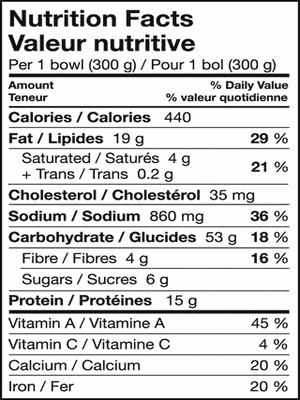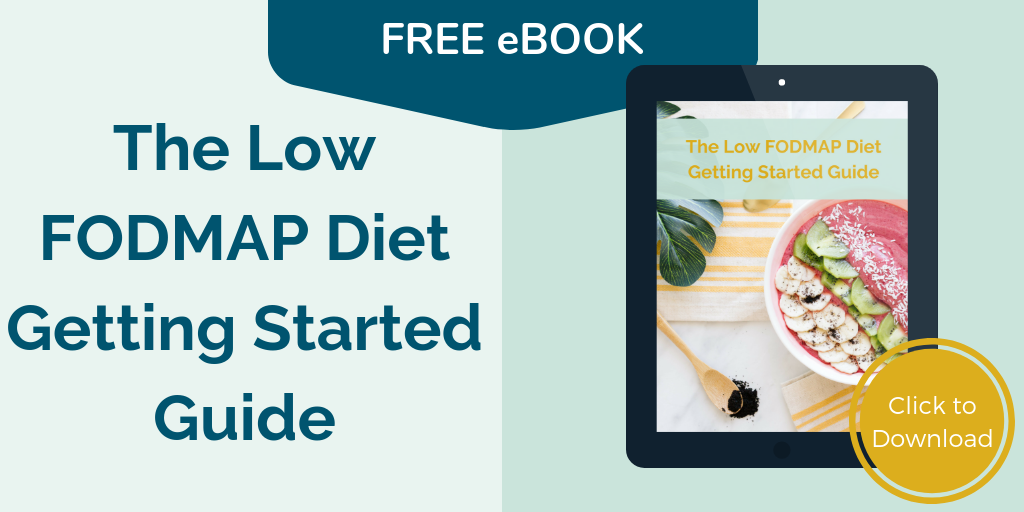If you’re following the low FODMAP diet, then you know it can be a challenge to choose packaged products that don’t contain any ingredients that could cause digestive upset (gas, bloating, pain, etc.). I love cooking real food in my kitchen and making meals from scratch, but there are many products that make their way into our lives – whether they help make quick meals, add flavour to dishes, or provide us with simple snacks. Thankfully there are numerous food companies who provide packaged products for those of us that have to avoid specific ingredients.
Nutrition labels and ingredient lists on food products are so important when it comes to making healthy decisions for our bodies. It’s especially important for those of us who suffer from Irritable Bowel Syndrome (IBS) or digestive distress, as our bowels are sensitive to many trigger foods, which can cause uncomfortable symptoms, like bloating, irregular bowel movements, and abdominal pain. By following the guidelines below, we hope to make the process of reading labels and choosing packaged foods a little easier.
The first step if you’re looking to improve irritable bowel syndrome (IBS) or another digestive disorder or disease, is to understand more about the Low FODMAP diet and if it can help. Download my free eBook to help you better understand this diet and get started implementing simple steps to get rid of symptoms like gas, bloating, pain, diarrhea or constipation related to IBS. Click here to get a copy emailed to you right away.
Tips for Reading Nutrition Labels
Nutrition labels were created to provide consumers with the nutritional information of the food they’re eating, so that we can make healthier food choices. But have you ever been stumped when trying to read one? Don’t be scared off by the numbers and percentages that fill up the nutrition facts table. The labels are meant to be used to help you compare one product to another. Remember to compare apples to apples and not apples to oranges 😉 What I mean is, when choosing a cracker for example, compare a couple different brands and choose the one with the best nutrition by using the following three tips for nutrition label reading for those who suffer from IBS and other digestive disorders.
Choose high-fibre foods
Soluble fibre acts as a bulking agent, decreasing the time it takes for food to move through our digestive system. This can be particularly helpful for those who suffer from constipation. However fibre can affect people with IBS differently, to learn more about fibre and IBS, read the article What’s all the Fuss about Fibre?
Soluble fibre also works to lower blood cholesterol levels and is great to help keep you feeling full longer. We should aim to have about 25-35 grams of fibre in a day; women need about 25 grams, whereas men need closer to 38 grams each day. So when reading food labels, try to choose the product that has the most fibre in it.
To increase your fibre intake while including foods that are good-for-your-gut, include the following high fibre foods daily:
- Chia seeds
- Sunflower seeds
- Sesame seeds and sesame butter
- Peanuts and peanut butter
- Lentils
- Oats
- Rice bran or oat bran (add to cereal or oatmeal)
- Quinoa and quinoa flakes
- Raspberries, Kiwi and blueberries
- Potatoes, pumpkin and parsnips

Increase your protein
Protein is important for so many functions in our bodies! Women need about 46 grams/day, and men need about 56 grams/day. So when comparing nutrition labels on packages, try to choose the product with the most protein. Dairy products such as lactose-free yogurt (especially Greek), lactose-free and hard cheeses, and lactose-free milk, are great low FODMAP options.
Limit the sugar and salt
These two are the culprits for many chronic diseases that are on the rise, like heart diseases and diabetes. Health Canada has established 1500 mg as the daily recommended value. However, most Canadians eat 3400 mg, that’s more than double what we need! If you’re looking to reduce salt intake, look for the word “sodium” on the label and choose the food with the least amount. Many food companies now have “low sodium” and “low sugar” alternatives for their products, so give those a try.
The most important label reading tip when you have IBS is reading the ingredient list for high FODMAP ingredients. FODMAPs are short-chained sugars that are poorly absorbed in the small intestine. Consumption of FODMAPs can lead to many of the uncomfortable symptoms that are associated with IBS. To learn more about the Low FODMAP diet, click here.

Finding FODMAPs in Ingredient Lists
FODMAPs can be easy when you’re cooking for yourself, as you know every single ingredient that goes into the recipe. It’s easy for us to avoid whole FODMAP foods, such as apples, cauliflower, or black beans by simply leaving them out of a recipe, but avoiding FODMAPs in packaged products is a bit trickier. You really need to know what to look for! There are sneaky FODMAPs that make their way into products, so you’ll want to look out for them in the ingredient list.
Here is a list of common ingredients to look out for. If these ingredients are present in a food product, you may wish to avoid.
- Honey
- Agave
- High fructose corn syrup
- Inulin
- Chicory root
- Sugar alcohols: sorbitol, mannitol, maltitol, xylitol, isomalt
- Onion powder (or any type of onion flavouring)
- Garlic powder (or any type of garlic flavouring)
- Bean flour (various types)
- Dried fruit
We hope that this article has given you some extra confidence to approach food labels in your grocery store. Remember, the best, healthiest, good-for-your-gut way to eat is with whole foods. My biggest recommendation is to limit packaged or processed food to just once per day.
Much love & good eating,
Stephanie and the Team


